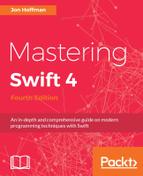To demonstrate the façade pattern, we will create three APIs: HotelBooking, FlightBooking, and RentalCarBookings. These APIs will be used to search for and book hotels, flights, and rental cars for trips. While we could very easily call each of the APIs individually in the code, we are going to create a TravelFacade structure that will allow us to access the functionality of the APIs in single calls.
We will begin by defining the three APIs. Each of the APIs will need a data storage class that will store the information about the hotel, flight, or rental car. We will start off by implementing the hotel API:
struct Hotel {
//Information about hotel room
}
struct HotelBooking {
static func getHotelNameForDates(to: Date, from: Date) ->[Hotel]? {
let hotels = [Hotel]()
//logic to get hotels
return hotels
}
static func bookHotel(hotel: Hotel) {
// logic to reserve hotel room
}
}
The hotel API consists of the Hotel and HotelBooking structures. The Hotel structure will be used to store the information about a hotel room and the HotelBooking structure will be used to search for a hotel room and to book the room for the trip. The flight and rental car APIs are very similar to the hotel API. The following code shows both of these APIs:
struct Flight {
//Information about flights
}
struct FlightBooking {
static func getFlightNameForDates(to: Date, from: Date) ->[Flight]? {
let flights = [Flight]()
//logic to get flights
return flights
}
static func bookFlight(flight: Flight) {
// logic to reserve flight
}
}
struct RentalCar {
//Information about rental cars
}
struct RentalCarBooking {
static func getRentalCarNameForDates(to: Date, from: Date)-> [RentalCar]? {
let cars = [RentalCar]()
//logic to get flights
return cars
}
static func bookRentalCar(rentalCar: RentalCar) {
// logic to reserve rental car
}
}
In each of these APIs, we have a structure that is used to store information and a structure that is used to provide the search/booking functionality. In the initial design, it would be very easy to call these individual APIs within the application; however, as we all know, requirements tend to change, which causes the APIs to change over time. By using the façade pattern here, we are able to hide how we implement the APIs; therefore, if we need to change how the APIs work in the future, we will only need to update the façade type rather than refactoring all of the code. This makes the code easier to maintain and update in the future. Now let's look at how we will implement the façade pattern by creating a TravelFacade class:
class TravelFacade {
var hotels: [Hotel]?
var flights: [Flight]?
var cars: [RentalCar]?
init(to: Date, from: Date) {
hotels = HotelBooking.getHotelNameForDates(to: to, from: from)
flights = FlightBooking.getFlightNameForDates(to: to, from:from)
cars = RentalCarBooking.getRentalCarNameForDates(to: to, from:from)
}
func bookTrip(hotel: Hotel, flight: Flight, rentalCar: RentalCar) {
HotelBooking.bookHotel(hotel: hotel)
FlightBooking.bookFlight(flight: flight)
RentalCarBooking.bookRentalCar(rentalCar: rentalCar)
}
}
The TravelFacade class contains the functionality to search the three APIs and book a hotel, flight, and rental car. We can now use the TravelFacade class to search for hotels, flights, and rental cars without having to directly access the individual APIs. We can also use the TravelFacade class to book the hotel, flights, and rental cars without having to access the individual APIs.
As we mentioned at the start of this chapter, it is not always obvious when we should use the façade pattern in the initial design.
A good rule to follow is: if we have several APIs that are working together to perform a task, we should think about using the façade pattern.
Now, let's look at the last structural pattern, which is the proxy design pattern.
